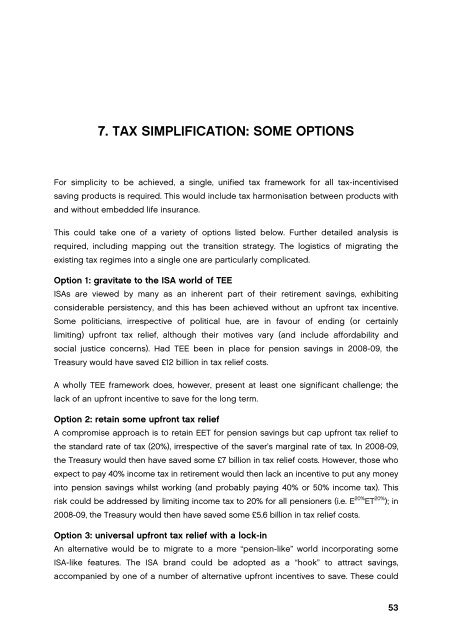Simplification is the key - Centre for Policy Studies
Simplification is the key - Centre for Policy Studies
Simplification is the key - Centre for Policy Studies
You also want an ePaper? Increase the reach of your titles
YUMPU automatically turns print PDFs into web optimized ePapers that Google loves.
7. TAX SIMPLIFICATION: SOME OPTIONS<br />
For simplicity to be achieved, a single, unified tax framework <strong>for</strong> all tax-incentiv<strong>is</strong>ed<br />
saving products <strong>is</strong> required. Th<strong>is</strong> would include tax harmon<strong>is</strong>ation between products with<br />
and without embedded life insurance.<br />
Th<strong>is</strong> could take one of a variety of options l<strong>is</strong>ted below. Fur<strong>the</strong>r detailed analys<strong>is</strong> <strong>is</strong><br />
required, including mapping out <strong>the</strong> transition strategy. The log<strong>is</strong>tics of migrating <strong>the</strong><br />
ex<strong>is</strong>ting tax regimes into a single one are particularly complicated.<br />
Option 1: gravitate to <strong>the</strong> ISA world of TEE<br />
ISAs are viewed by many as an inherent part of <strong>the</strong>ir retirement savings, exhibiting<br />
considerable pers<strong>is</strong>tency, and th<strong>is</strong> has been achieved without an upfront tax incentive.<br />
Some politicians, irrespective of political hue, are in favour of ending (or certainly<br />
limiting) upfront tax relief, although <strong>the</strong>ir motives vary (and include af<strong>for</strong>dability and<br />
social justice concerns). Had TEE been in place <strong>for</strong> pension savings in 2008-09, <strong>the</strong><br />
Treasury would have saved £12 billion in tax relief costs.<br />
A wholly TEE framework does, however, present at least one significant challenge; <strong>the</strong><br />
lack of an upfront incentive to save <strong>for</strong> <strong>the</strong> long term.<br />
Option 2: retain some upfront tax relief<br />
A comprom<strong>is</strong>e approach <strong>is</strong> to retain EET <strong>for</strong> pension savings but cap upfront tax relief to<br />
<strong>the</strong> standard rate of tax (20%), irrespective of <strong>the</strong> saver’s marginal rate of tax. In 2008-09,<br />
<strong>the</strong> Treasury would <strong>the</strong>n have saved some £7 billion in tax relief costs. However, those who<br />
expect to pay 40% income tax in retirement would <strong>the</strong>n lack an incentive to put any money<br />
into pension savings whilst working (and probably paying 40% or 50% income tax). Th<strong>is</strong><br />
r<strong>is</strong>k could be addressed by limiting income tax to 20% <strong>for</strong> all pensioners (i.e. E 20% ET 20% ); in<br />
2008-09, <strong>the</strong> Treasury would <strong>the</strong>n have saved some £5.6 billion in tax relief costs.<br />
Option 3: universal upfront tax relief with a lock-in<br />
An alternative would be to migrate to a more “pension-like” world incorporating some<br />
ISA-like features. The ISA brand could be adopted as a “hook” to attract savings,<br />
accompanied by one of a number of alternative upfront incentives to save. These could<br />
53

















